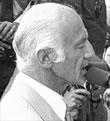FOR PRESS PM. No. 51/ l72
PRODUCTION OF PROJECT " N"
Statement by the Prime Minister, the Rt. Hon. William Mcahon,
CH, MP
The Prime Minister announced in Canberra today that the
Government had approved the production of an initial batch of twenty
Project aircraft, at a cost of $ 13M, including the cost of
completing development work and establishing production.
In January 1970, the Government approved expenditure of
$ 3.2M for the design, development and construction of two flying
prototypes and a structural teqt airframe. A further $ 1.1M, for the
second phase of the project was approved last year.
The Prime Minister said " Eleven of the first production
batch will be used by Army Aviation to replace their Cessna aircraft.
These aircraft will be used for command liaison and observation task&
in close support of the Army."
" The remaining nine aircraft of the initial batch will be
produced for sale to commercial or other users."
" It is Government policy to maintain a small but viable and
effective aircraft industry in Australia. To this end, the Government
is actively considering a rationalisation of the existing facilitics
in the aircraft industry."
" Employment in the industry had risen to high levels withthe
Mirage and Macchi projects and workload in the industry has
declined with the end of these two projects. This experience has
highlighted that the industry has so far been unable to establish a
significant market outside the dcfence area."
" The Government's concern for the future of the industry
had led it to initiate efforts to establish an improved workload
for the industry." " Project had been conceived to maintain essential ddsign
teams intact for defence purposes and oroduce a product that had both
military and civil potential. The Government had also embarked in
1971 upon a comprehensive programme of local production of light
observation helicooters for both military and civil use." / 2
" In addition, the Government had initiated a programme ofseeking
offsets to overseas Government purchases aimed at diversifying
the industry's market and bringing it into close commercial contact
with overseas industries. The development of Project has proceeded
remarkably well. This augurs very well for its success."
" The Government is confident that the widespread interest
being expressed in Project IN' will mean a successful commercial future
for the project in addition to the Australian military requirements 16
the aircraft. The combination of a military and a civil demand for
the aircraft should provide a long term and steady workload."
" The light utility aircraft, powered by two Allison 250
series 400 HP turbo-prop engines, was designed at the Department of
Supply's Government Aircraft Factories in Melbourne for use in military
and civil versions. Two prototypes have flown more than 280* hours and
have met or exceeded their design parameters."
" The aircraft shows great pComise as a low-cost easily
operated utility vehicle. It is widely adaptable in a range of both
military and civil ab-lications. Its outstanding short take-off and
landing ( STOL) characteristics, with its rugged performance in operating
from rough fields should ensure its sales success. A novel lateral.
control system, providing safe operation at or near the stalling speed,
overcomes one of the major hazards in STOL operation".
" These factors together with the combination of a relatively
high crubing speed with a good rate of climb and excellent rangepayload
capabilities puts this aircraft in a market slot in which there
is no present competitor."
" Project IN' represents a significant design achievement by
Australians and the team at GAF is to be congratulated."
The characteristics of Project are
All-up weight ( AUW) for take-off and landing 8,000 lbs
Rate of climb on two engines at AUW 1700 ft/ mmn.
Rate of climb on single engine at AUW 450 ft/ mmn.
Service ceiling at AUW 25000 ft
Cruise speed at AUW 175 kt.
Stall speed at AUW 47 kt.
Maximum range at normal cruise 950 n. miles
Maximum endurance 10 hrs.
Take-off and landing distances over 50 ft
obstacle at AMW using STOL characteristics
Normal temperature and) 960 ft. ( take-off) 960 ft
conditions ( ISA) 690 ft. ( landing) 690 ft.
High ambient temperature) 1400 ft. ( take-off) 1400 ft,
( ISA 250) 750 ft. ( landing) 750 ft.
Dimensions: Wing span 54 ft
Length 41 ft 2 in.
Height 17 ft 11 in.
Typical passenger/ range capacities:
12 passengers over 150 n. miles
9 passengers over 450 n. miles
6 passengers over 750 n. miles
CANBERRA, 23 May 1972

